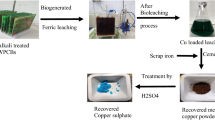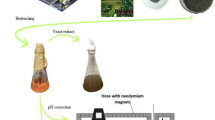Abstract
Absolute recoveries of target metals are rarely achieved in printed circuit board (PCB) leaching operations and this is ultimately a threat to complete cyclic material use. Leaching pulps contain high fractions of fiberglass particles, a ceramic material whose behavior in leaching pulps has not been studied but generally considered inert to lixiviants. Tests in this work, under basic and acidic lixiviants, show this is not so. Copper and zinc ions and ammine complexes, as well as iron ions were confirmed lost to fiberglass particles from basic and acid PCB leach solutions. Copper loss reached 0.695 mg per gram fiberglass particles in solution. Different mechanisms may apply in these interactions. Under the amine leaching, based on pHpzc study of fiberglass, it can be inferred that physisorption is responsible for losses observed. pHpzc of fiberglass was found to be 7.1. Hence, cationic complexes such as Cu(NH3)22+ and Zn(NH3)22+ under alkaline leaching conditions can be adsorbed. Under acid leaching, ion exchange is possible for losses observed. Fiberglass particles adsorb or exchange target metal ions during acidic and alkaline PCB leaching, thus limiting maximum possible recovery during recycling. These mechanisms are probable to understand and manage this loss.





Similar content being viewed by others
References
Oluokun OO, Otunniyi IO (2020) Kinetic analysis of Cu and Zn dissolution from printed circuit board physical processing dust under oxidative ammonia leaching. Hydrometallurgy. https://doi.org/10.1016/j.hydromet.2020.105320
Huang Y-F, Pan M-W, Lo S-L (2020) Hydrometallurgical metal recovery from waste printed circuit boards pretreated by microwave pyrolysis. Resour Conserv Recycl 163:105090
Marappa N, Ramachandran L, Dharumadurai D, Nooruddin T (2020) Recovery of gold and other precious metal resources from environmental polluted E-waste printed circuit board by bioleaching Frankia. Int J Environ Res 14(2):165–176
Barnwal A, Dhawan N (2020) Investigation of discarded printed circuit boards for recovery of copper values. JOM 72(8):2983–2992
Yousefzadeh S, Yaghmaeian K, Mahvi AH, Nasseri S, Alavi N, Nabizadeh R (2020) Comparative analysis of hydrometallurgical methods for the recovery of Cu from circuit boards: optimization using response surface and selection of the best technique by two-step fuzzy AHP-TOPSIS method. J Clean Prod 249:119401
Wang J, Zhang M, Lu YJASC (2020) Study of gold leaching behavior in the chlorination process from waste printed circuit boards. ACS Sustain Chem Eng 9(1):284–290
Ogunniyi I, Vermaak M, Groot D (2009) Chemical composition and liberation characterization of printed circuit board comminution fines for beneficiation investigations. Waste Manage 29(7):2140–2146
Tatariants M, Yousef S, Denafas G, Bendikiene R (2018) Separation and purification of metal and fiberglass extracted from waste printed circuit boards using milling and dissolution techniques. Environ Prog Sustain Energy 37(6):2082–2092
Pereira Gonçalves P, Otsuki A (2019) Determination of liberation degree of mechanically processed waste printed circuit boards by using the digital microscope and SEM-EDS analysis. Electronics 8(10):1202
Annamalai M, Gurumurthy K (2021) Characterization of end-of-life mobile phone printed circuit boards for its elemental composition and beneficiation analysis. J Air Waste Manag Assoc 71(3):315–327
Oluokun OO, Otunniyi IO (2020) Chemical conditioning for wet magnetic separation of printed circuit board using octyl phenol ethoxylate. Sep Purif Technol. https://doi.org/10.1016/j.seppur.2020.116586
Oraby EA, Li H, Eksteen JJ (2020) An alkaline glycine-based leach process of base and precious metals from powdered waste printed circuit boards. Waste Biomass Valor 11(8):3897–3909
Park Y, Eom Y, Yoo K, Jha MK (2021) Leaching of copper from waste-printed circuit boards (PCBs) in sulfate medium using cupric ion and oxygen. Metals 11(9):1369
Longobardo AV (2010) Glass fibers for printed circuit boards. In: Wallenberger F, Bingham P (eds) Fiberglass and glass technology. Springer, Boston, MA. https://doi.org/10.1007/978-1-4419-0736-3_4
Janacova D et al (2019) Simulation of printed circuit boards recycling process. MATEC Web Conf 292:01040
Burat F, Özer M (2018) Physical separation route for printed circuit boards. Physicochem Probl Miner Proc. https://doi.org/10.5277/ppmp1858
LW. Ritchey and S. Edge. A survey and tutorial of dielectric materials used in the manufacture of printed circuit boards. Circuitree magazine, 1999.
Kovács B, Géczy A, Horváth G, Hajdu I, Gál L (2016) Advances in producing functional circuits on biodegradable PCBs. Periodica Polytech Electr Eng Comput Sci 60(4):223–231
Li H, Richards C, Watson J (2014) High-performance glass fiber development for composite applications. Int J Appl Glas Sci 5(1):65–81
ASTM. ASTM D578/D578M-05(2011). Standard specification for glass fiber strands. West Conshohocken, PA: ASTM International; 2011. www.astm.org
Coombs CF Jr (2008) Printed circuits handbook. McGraw-Hill Education, Noida
Sellaoui L et al (2021) Trapping of Ag+, Cu2+, and Co2+ by faujasite zeolite Y: new interpretations of the adsorption mechanism via DFT and statistical modeling investigation. Chem Eng J 420:127712
Aziz R, Fauzi N, Salleh M, Saleh M (2021) Removal of copper and magnesium cations from aqueous solutions by clinoptilolite zeolite adsorption. IOP Conf Ser Earth Environ Sci 765(1):012028
Kobayashi Y, Ogata F, Saenjum C, Nakamura T, Kawasaki N (2021) Adsorption/desorption capability of potassium-type zeolite prepared from coal fly ash for removing of Hg2+. Sustainability 13(8):4269
Muhamad N et al (2021) Composite zeolite hollow fiber membrane for the removal of nickel using forward osmosis. J Water Proc Eng 40:101806
Oluokun OO, Otunniyi IO (2023) Removal of iron from waste printed circuit board dust: surfactant assisted magnetic separation versus selective leaching routes. J Mater Cycles Waste Manage 25(3):1710–1718
Hasanuzzaman M, Rafferty A, Sajjia M, Olabi A-G (2016) Properties of glass materials. Reference module in materials science and materials engineering, Elsevier. https://doi.org/10.1016/B978-0-12-803581-8.03998-9
Smičiklas ID, Milonjić SK, Pfendt P, Raičević S (2000) The point of zero charge and sorption of cadmium (II) and strontium (II) ions on synthetic hydroxyapatite. Sep Purif Technol 18(3):185–194
Alemu A, Lemma B, Gabbiye N, Alula MT, Desta MT (2018) Removal of chromium (VI) from aqueous solution using vesicular basalt: a potential low cost wastewater treatment system. Heliyon 4(7):e00682
Acar M, Altun T, Gubbuk I (2022) Synthesis and characterization of silver doped magnetic clay nanocomposite for environmental applications through effective RhB degradation. Int J Environ Sci Technol. https://doi.org/10.1007/s13762-022-04256-y
Ochromowicz K, Jeziorek M, Wejman K (2014) Copper (II) extraction from ammonia leach solution. Physicochem Probl Miner Proc. https://doi.org/10.5277/ppmp140127
Meng X, Han KN (1996) The principles and applications of ammonia leaching of metals—a review. Miner Proc Extr Metullargy Rev 16(1):23–61
Tran HN, You S-J, Hosseini-Bandegharaei A, Chao H-P (2017) Mistakes and inconsistencies regarding adsorption of contaminants from aqueous solutions: a critical review. Water Res 120:88–116
Ogunniyi I, Vermaak M (2009) Investigation of froth flotation for beneficiation of printed circuit board comminution fines. Miner Eng 22(4):378–385
Zu Q, Solvang M, Li H (2021) Commercial glass fibers. In: Fiberglass science and technology: Chemistry, characterization, processing, modelling, application, and sustainability. Springer, Cham, pp 1–87
Williamson AJ et al (2021) Selective leaching of copper and zinc from primary ores and secondary mineral residues using biogenic ammonia. J Hazard Mater 403:123842
Dong D (1999) Fiberglass surface and its electrokinetic properties. Int Nonwovens J. https://doi.org/10.1177/1558925099OS-800218
Leed EA, Sofo JO, Pantano CG (2005) Electronic structure calculations of physisorption and chemisorption on oxide glass surfaces. Phys Rev B 72(15):155427
D’Souza AS, Pantano CG (2002) Hydroxylation and dehydroxylation behavior of silica glass fracture surfaces. J Am Ceram Soc 85(6):1499–1504
Ning C, Hadi P, Xu M, Lin CSK, McKay G (2016) Valorization of an electronic waste-derived aluminosilicate: Surface functionalization and porous structure tuning. ACS Sustain Chem Eng 4(6):2980–2989
Hadi P, Ning C, Ouyang W, Lin CSK, Hui C-W, McKay G (2014) Conversion of an aluminosilicate-based waste material to high-value efficient adsorbent. Chem Eng J 256:415–420
Hadi P, Ning C, Ouyang W, Xu M, Lin CS, McKay G (2015) Toward environmentally-benign utilization of nonmetallic fraction of waste printed circuit boards as modifier and precursor. Waste Manage 35:236–246
Krauklis AE, Echtermeyer AT (2018) Long-term dissolution of glass fibers in water described by dissolving cylinder zero-order kinetic model: mass loss and radius reduction. Open Chem 16(1):1189–1199
AE Krauklis, AT Echtermeyer. Dissolving Cylinder Zero-Order Kinetic Model for Predicting Hygrothermal Aging of Glass Fiber Bundles and Fiber-Reinforced Composites, in Proceedings of the 4th International Glass Fiber Symposium, Aachen, Germany, 2018, pp. 29–30.
Nachod FC, Schubert J (2013) Ion exchange technology. Academic Press, Cambridge
Chen JP, Wang L (2001) Characterization of a Ca-alginate based ion-exchange resin and its applications in lead, copper, and zinc removal. Sep Sci Technol 36(16):3617–3637
Bashir A et al (2019) Removal of heavy metal ions from aqueous system by ion-exchange and biosorption methods. Environ Chem Lett 17(2):729–754
Acknowledgements
This work was funded from research funds of the Department of Chemical and Metallurgical Engineering, Vaal University of Technology. No other external funding was received from other funding agencies in the public, commercial, or not-for-profit sectors.
Funding
Faculty of Engineering and Technology, Vaal University of Technology.
Author information
Authors and Affiliations
Corresponding author
Ethics declarations
Conflict of interest
The authors declare that they have no conflict of interest.
Additional information
Publisher's Note
Springer Nature remains neutral with regard to jurisdictional claims in published maps and institutional affiliations.
Rights and permissions
Springer Nature or its licensor (e.g. a society or other partner) holds exclusive rights to this article under a publishing agreement with the author(s) or other rightsholder(s); author self-archiving of the accepted manuscript version of this article is solely governed by the terms of such publishing agreement and applicable law.
About this article
Cite this article
Oluokun, O.O., Otunniyi, I.O. Recovery limitation due to metal loss to fiberglass particles during printed circuit board leaching and probable mechanisms. J Mater Cycles Waste Manag 26, 313–321 (2024). https://doi.org/10.1007/s10163-023-01822-5
Received:
Accepted:
Published:
Issue Date:
DOI: https://doi.org/10.1007/s10163-023-01822-5




